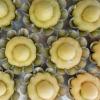
"Pan de Cristal" With Hamelman's Ciabatta with stiff biga formula
Just after the new year, I had a delicious pan con tomate served on pan de cristal at a tapas restaurant. I wanted to give this bread a shot at home. Its properties are unique - the crust is shatteringly thin, and the crumb is so airy it barely exists at all. Prior to serving, it is toasted until crispy. Though its structure resembles that of a rustic ciabatta, it is not chewy but light and crisp.
After consulting this extensive post on TFL, I decided to use Hamelman's ciabatta with stiff biga formula , increasing the hydration to 80% and beating the slack dough with the paddle attachment until the smooth windowpane stage. I elected to use the stiff biga version instead of the poolish version of ciabatta because I thought that the extra protease activity would be counterproductive to creating the lofty structure of an already-slack dough.
Here are the loaves, which were cut and gingerly stretched out to long, thin rectangles:
The loaves took almost an hour to brown at 460 F. I flipped them over twenty minutes into the bake to get a more even crust on both sides. One of the longer, wider loaves tried to escape from my flipping board and ended up deformed. I would have liked more browning, but I was concerned that the crust would become too thick and hard.
Here is the crumb:
There are hints of potential in these loaves. Below is a cherry-picked sample of the part of the crumb that comes closest to what pan de cristal should be:
Most of the crumb was much denser. There were several shortcomings of this bake:
- The crust was too hard and thick, which is made worse by toasting. Let's just say that my molars are well-polished. I wonder whether it would be better not to flip the loaves during the bake, and to simply cut off and discard the thick bottom crust that contacts the baking stone prior to serving. It is also possible that there was not enough steam in the oven. I might also try increasing the baking temperature to 500 and shaping thinner loaves so that they bake more quickly.
- the crumb was not open enough. I think the intensive mix may have contributed to this. Next time, I might try more stretching and folding, combined with a slightly lower hydration - perhaps 75%.
- The flavor was quite bland. The reluctant browning was the first hint that the loaves would turn out this way.
Nonetheless, we enjoyed the bread with roasted bone marrow, piquillo peppers and manchego cheese. It's surprising how difficult it is to find authoritative information about pan de cristal online. If any TFLers have inside information about how to reproduce it, please do share!


Comments
At first look, I thought nicely done!...and at a closer glance I saw the words 'roasted bone marrow,' my mouth started to water. Good lord what a combo that must have been! Nicely done :)
John
Your description of Pan de Crystal really made me swoon. Oooh, I love that sort of bread, a sort of bread I dream of! :D
And very interesting post about your trial to re-create bread you liked by yourself. Many of my recipes were born by lots of trials and errors like that, too.
I haven't yet been able to produce a ciabatta-like bread that I can be satisfied with yet, so I can't give you any tip or info that'd be useful for you, but nevertheless I'll be very interested to follow further reports on your pursuit.
Thank you for sharing your experience and good luck! :)